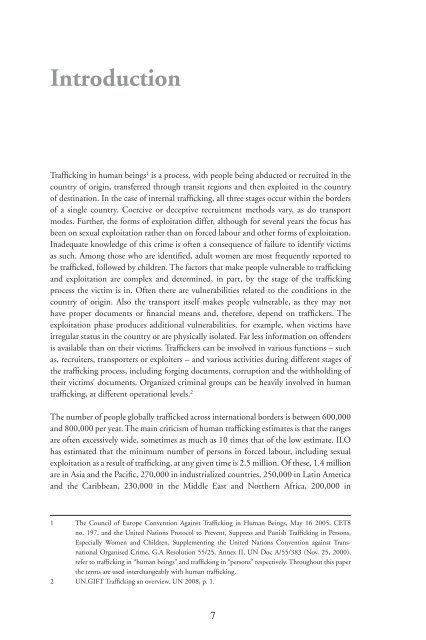Trafficking in human beings: human rights and ... - unesdoc - Unesco
Trafficking in human beings: human rights and ... - unesdoc - Unesco
Trafficking in human beings: human rights and ... - unesdoc - Unesco
You also want an ePaper? Increase the reach of your titles
YUMPU automatically turns print PDFs into web optimized ePapers that Google loves.
Introduction<br />
Traffi ck<strong>in</strong>g <strong>in</strong> <strong>human</strong> be<strong>in</strong>gs 1 is a process, with people be<strong>in</strong>g abducted or recruited <strong>in</strong> the<br />
country of orig<strong>in</strong>, transferred through transit regions <strong>and</strong> then exploited <strong>in</strong> the country<br />
of dest<strong>in</strong>ation. In the case of <strong>in</strong>ternal traffi ck<strong>in</strong>g, all three stages occur with<strong>in</strong> the borders<br />
of a s<strong>in</strong>gle country. Coercive or deceptive recruitment methods vary, as do transport<br />
modes. Further, the forms of exploitation differ, although for several years the focus has<br />
been on sexual exploitation rather than on forced labour <strong>and</strong> other forms of exploitation.<br />
Inadequate knowledge of this crime is often a consequence of failure to identify victims<br />
as such. Among those who are identifi ed, adult women are most frequently reported to<br />
be traffi cked, followed by children. The factors that make people vulnerable to traffi ck<strong>in</strong>g<br />
<strong>and</strong> exploitation are complex <strong>and</strong> determ<strong>in</strong>ed, <strong>in</strong> part, by the stage of the traffi ck<strong>in</strong>g<br />
process the victim is <strong>in</strong>. Often there are vulnerabilities related to the conditions <strong>in</strong> the<br />
country of orig<strong>in</strong>. Also the transport itself makes people vulnerable, as they may not<br />
have proper documents or fi nancial means <strong>and</strong>, therefore, depend on traffi ckers. The<br />
exploitation phase produces additional vulnerabilities, for example, when victims have<br />
irregular status <strong>in</strong> the country or are physically isolated. Far less <strong>in</strong>formation on offenders<br />
is available than on their victims. Traffi ckers can be <strong>in</strong>volved <strong>in</strong> various functions – such<br />
as, recruiters, transporters or exploiters – <strong>and</strong> various activities dur<strong>in</strong>g different stages of<br />
the traffi ck<strong>in</strong>g process, <strong>in</strong>clud<strong>in</strong>g forg<strong>in</strong>g documents, corruption <strong>and</strong> the withhold<strong>in</strong>g of<br />
their victims’ documents. Organized crim<strong>in</strong>al groups can be heavily <strong>in</strong>volved <strong>in</strong> <strong>human</strong><br />
traffi ck<strong>in</strong>g, at different operational levels. 2<br />
The number of people globally traffi cked across <strong>in</strong>ternational borders is between 600,000<br />
<strong>and</strong> 800,000 per year. The ma<strong>in</strong> criticism of <strong>human</strong> traffi ck<strong>in</strong>g estimates is that the ranges<br />
are often excessively wide, sometimes as much as 10 times that of the low estimate. ILO<br />
has estimated that the m<strong>in</strong>imum number of persons <strong>in</strong> forced labour, <strong>in</strong>clud<strong>in</strong>g sexual<br />
exploitation as a result of traffi ck<strong>in</strong>g, at any given time is 2.5 million. Of these, 1.4 million<br />
are <strong>in</strong> Asia <strong>and</strong> the Pacifi c, 270,000 <strong>in</strong> <strong>in</strong>dustrialized countries, 250,000 <strong>in</strong> Lat<strong>in</strong> America<br />
<strong>and</strong> the Caribbean, 230,000 <strong>in</strong> the Middle East <strong>and</strong> Northern Africa, 200,000 <strong>in</strong><br />
1 The Council of Europe Convention Aga<strong>in</strong>st Traffi ck<strong>in</strong>g <strong>in</strong> Human Be<strong>in</strong>gs, May 16 2005, CETS<br />
no. 197, <strong>and</strong> the United Nations Protocol to Prevent, Suppress <strong>and</strong> Punish Traffi ck<strong>in</strong>g <strong>in</strong> Persons,<br />
Especially Women <strong>and</strong> Children, Supplement<strong>in</strong>g the United Nations Convention aga<strong>in</strong>st Transnational<br />
Organised Crime, G.A Resolution 55/25, Annex II, UN Doc A/55/383 (Nov. 25, 2000),<br />
refer to traffi ck<strong>in</strong>g <strong>in</strong> “<strong>human</strong> be<strong>in</strong>gs” <strong>and</strong> traffi ck<strong>in</strong>g <strong>in</strong> “persons” respectively. Throughout this paper<br />
the terms are used <strong>in</strong>terchangeably with <strong>human</strong> traffi ck<strong>in</strong>g.<br />
2 UN.GIFT Traffi ck<strong>in</strong>g an overview. UN 2008, p. 1.<br />
7

















